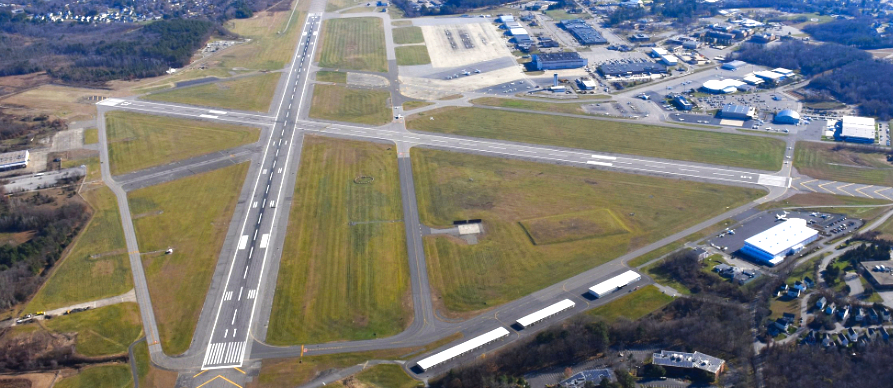
An airport is designate as a towered airport when it has an operating Air Traffic Control (ATC) tower. Air traffic control (ATC) is responsible for providing the safe, orderly, and expeditious flow of air traffic at airports where the type of operations and/or volume of traffic requires such a service.
These airports are typically busier and may have more complex air traffic operations than non-towered airports, which do not have ATC towers and rely on pilots to coordinate their actions.
When operating at or within the airspace of a towered airport, pilots must communicate with the ATC tower for instructions on taxiing, runway assignments, and clearances for takeoff and landing.
There are three types of airspace that surrounds towered airports.
- Class B (Class Bravo) (think big / busy / Boeing) The airspace that surrounds the biggest airports ie. Boston Logan Airport
- Class C (Charlie) (think crowded) The airspace that has a lot of traffic but not as busy as a Class B airport ie. Manchester NH Airport
- Class D (Delta) (think dialogue) Airports that are busy enough to require a tower to operate but not as big or as busy as a Class B or C. i.e Hanscom Airport, Bedford MA.
Class B Airspace
Class B airspace is generally airspace from the surface to 10,000 feet MSL surrounding the nation’s busiest airports in terms of airport operations or passenger enplanements. (ie. Boston Logan Airport)
The configuration of each Class B airspace area is individually tailored, consists of a surface area and two or more layers.
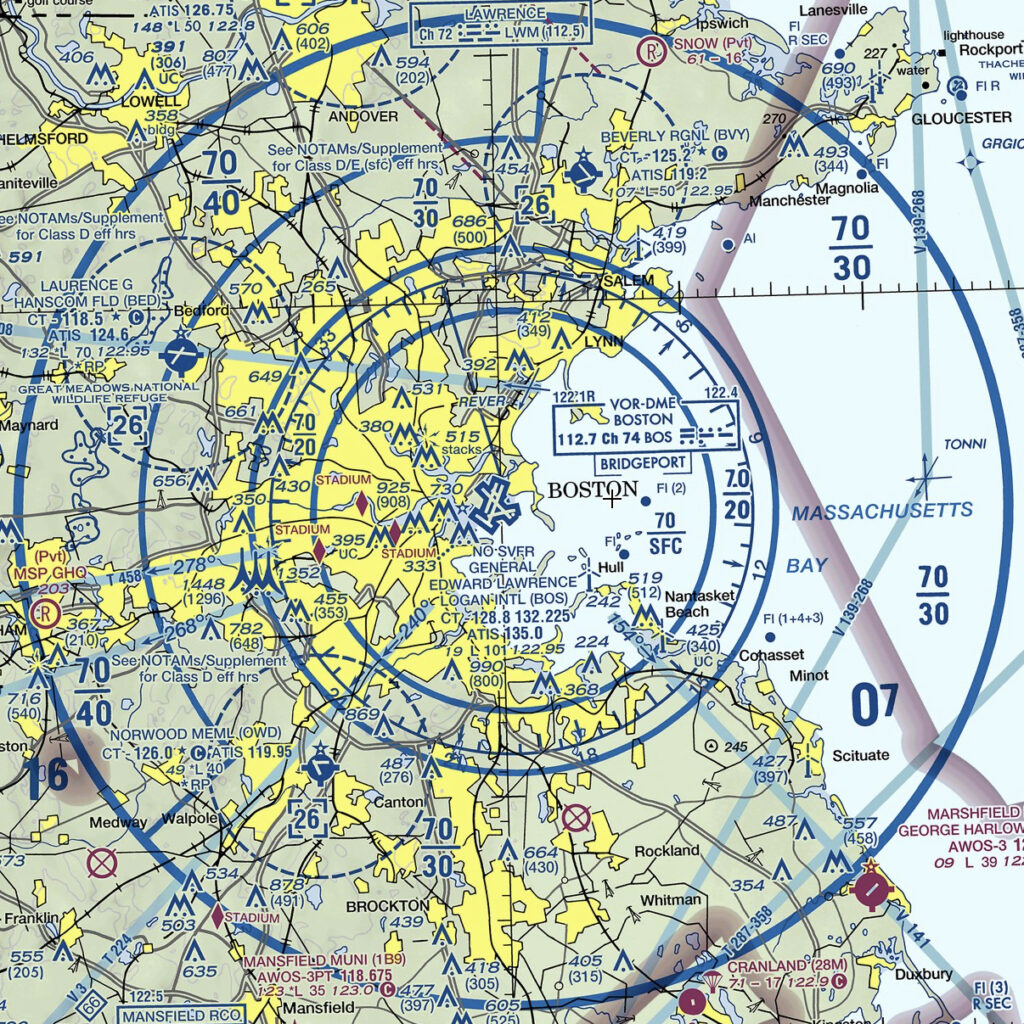
Some Class B airspace areas are said to resemble upside-down wedding cakes,
- Multiple Layers: Class B airspace typically consists of several layers that expand outward as altitude increases.
- Upside-down Wedding Cake Shape: The bottom layer starts near the surface around the airport, and as you move outward, the airspace extends to higher altitudes in wider rings.
- Ceiling: Class B airspace generally extends up to 10,000 feet MSL (though it can be higher or lower in some locations) and is designed to contain all published instrument procedures once an aircraft enters the airspace.
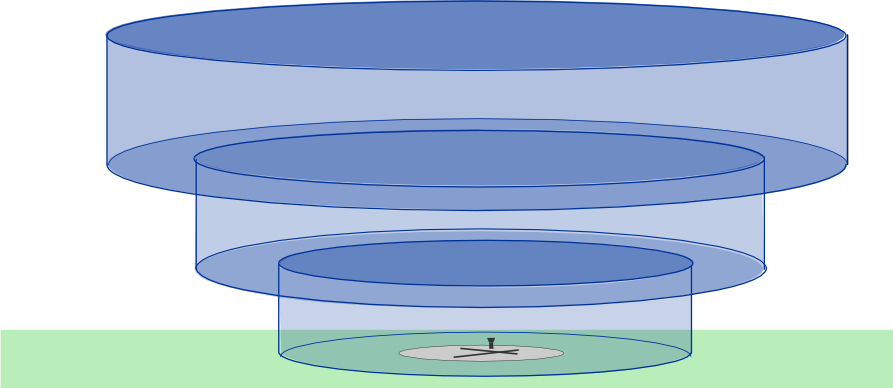
An ATC clearance is required for all aircraft to operate in Class B airspace, and all aircraft that are so cleared receive separation services within the airspace.
Equipment Requirements
- A two-way radio.
- A Mode-C transponder (automatic altitude reporting capability) inside the Mode C Veil.
- ADS-B Out inside the Mode C Veil.
- If flying under IFR, you’ll need a VOR or TACAN receiver, or an RNAV system (GPS).
Pilot Requirements
You’re allowed to enter Class B airspace only if:
- The PIC (Pilot in Command) holds at least a private pilot certificate.
- The PIC holds a recreational pilot certificate and meets the requirements of 14 CFR § 61.101.
- The PIC holds a sport pilot certificate with 14 CFR § 61.325 endorsements.
- You’re a student training for a private pilot certificate with an endorsement for 14 CFR § 61.95.
- You’re a student training for a recreational or sport pilot certificate with endorsements for 14 CFR § 61.94.
Note: ECAC does not permit student pilots to fly solo in Class B airspace.
There are some Class B airports that require a minimum of a private pilot certificate. These primary airports have some of the country’s busiest and most complex airspace. They cannot afford to give student, sport, and recreational pilots the necessary attention. There are twelve of these such airports – Boston Logan International Airport is one of these airports
Airports requiring at least a private pilot license to take off or land solo at the following airports. (“The dirty dozen”)
| FAA LID / ICAO Code | Airport Name |
| ADW / KADW | Andrews Air Force Base, MD. |
| ATL / KATL | Atlanta Hartsfield Airport, GA. |
| BOS / KBOS | Boston Logan Airport, MA. |
| ORD / KORD | Chicago O’Hare Intl. Airport, IL. |
| DFW / KDFW | Dallas/Fort Worth Intl. Airport, TX. |
| LAX / KLAX | Los Angeles Intl. Airport, CA. |
| MIA / KMIA | Miami Intl. Airport, FL. |
| EWR / KEWR | Newark Intl. Airport, NJ. |
| JFK / KJFK | New York Kennedy Airport, NY. |
| LGA / KLGA | New York La Guardia Airport, NY. |
| DCA / KDCA | Ronald Reagan Washington National Airport, DC. |
| SFO / KSFO | San Francisco Intl. Airport, CA. |
Weather Requirements
VFR weather requirements can be found in 14 CFR § 91.155.
VFR operations in Class B require:
- Flight Visibility of at least three statute miles.
- Remaining clear of clouds with no minimum distance requirement.
These limits aren’t as strict as those in other controlled airspace classes because ATC tracks all traffic closely and handles the separation between all aircraft.
However, additional visibility requirements exist for VFR traffic at a primary airport. If the airport reports ground visibility of less than three statute miles, you can’t take off, land, or enter the traffic pattern. At airports that don’t have ground visibility equipment, use flight visibility instead.
Class B primary airports will also restrict VFR operations when the ceiling is less than 1,000 feet.
How to Enter Class B Airspace
VFR aircraft must remain outside the Class B until the controller clears them to enter.
To request a Bravo clearance, you must call the approach controller on the appropriate frequency and provide your callsign, location, altitude, and destination. The controller will identify you on radar, assign you a squawk code, and clear you into the airspace.
If you’re departing from a satellite airport under Class B, call approach right after takeoff. If the satellite airport has a control tower, they can help coordinate. However, you must receive clearance from approach control before entering Class B airspace.
Bravo airspace is almost always busy. But it can be particularly hectic at certain times of the day. This is called a ‘push’. ATC is very likely to refuse VFR Bravo clearances during a push. They’ll ask you to remain outside Bravo airspace and advise you when to expect further clearance.
How to Operate Inside Class B Airspace
Once inside the Bravo, you must pay strict attention. You’re responsible for maintaining situational awareness, ATC communication, and following airspace rules. The airspace is busy, and there is no room for error.
Airspeed Restrictions
Almost all Class B airspace exists below 10,000 feet. This effectively limits traffic in Class B to 250 knots due to 14 CFR § 91.117(a).
Traffic flying under a shelf or through a VFR corridor needs to stay below 200 knots.
Traffic Separation
ATC will separate VFR traffic from all other VFR and IFR aircraft. They’ll provide at least 500 feet of vertical separation. Lateral separation will be at least 1 ½ miles for jets and large aircraft or target resolution for small aircraft. ATC may allow visual separation at its discretion.
Landing at Class B Airports
If you plan to land at a Class B airport, here’s what you need to know.
Call ahead to prearrange your arrival. ATC will advise you of the off-peak times when entry into the airspace is less likely to be denied.
Don’t attempt a landing at a Class B airport without extensive preparation. Listen to ATC transmissions to familiarize yourself with the airspace. Learn the typical approaches and altitudes. Determine the common taxi routes.
Controllers juggle a large number of aircraft at any given time. Clearances can be long and complex, and you must keep up with rapid-fire ATC chatter. You’ll need to stay sharp even after landing. Taxi clearances can be very complicated.
Has it been a while since you flew out of a busy commercial airport? Consider improving your skills at a busy Class D or C airport first.
How to Get Around Class B Airspace
Compared to other airport airspaces like Classes C and D, Class B airspace is huge! The widest shelves can extend as far as 30 miles from the primary airport.
That’s a considerable detour for small general aviation aircraft. Terrain or weather around the airspace can add time and fuel consumption. Here’s how to bypass the Bravo.
Flying Under or Around Class B
Despite its imposing size, you can transit the Class B airspace without major detours by just flying underneath a shelf!
A clearance is not required since you will not be entering Bravo airspace. However, you will need an operating Mode C transponder and ADS-B Out.
Additionally, you must adhere to a maximum speed of 200 knots, as stipulated by 14 CFR § 91.117(c).
As a Visual Flight Rules (VFR) pilot, traffic avoidance becomes your sole responsibility.
Be prepared for substantial traffic congestion in Class B airspace.
The reduced speeds enhance your visibility and enable you to effectively avoid other aircraft.
Stay clear of the Class B boundaries if you’re flying under a shelf with a floor less than 3,000 feet AGL. This prevents unintended airspace incursions and provides a safety buffer from traffic.
Class C Airspace
Class C (Class Charlie) (think crowded)
Class C airspace is generally airspace from the surface to 4,000 feet above the airport elevation (charted in MSL) surrounding those airports that have an operational control tower, are serviced by a radar approach control, and have a certain number of IFR operations or passenger enplanements. (ie. Manchester NH Airport)
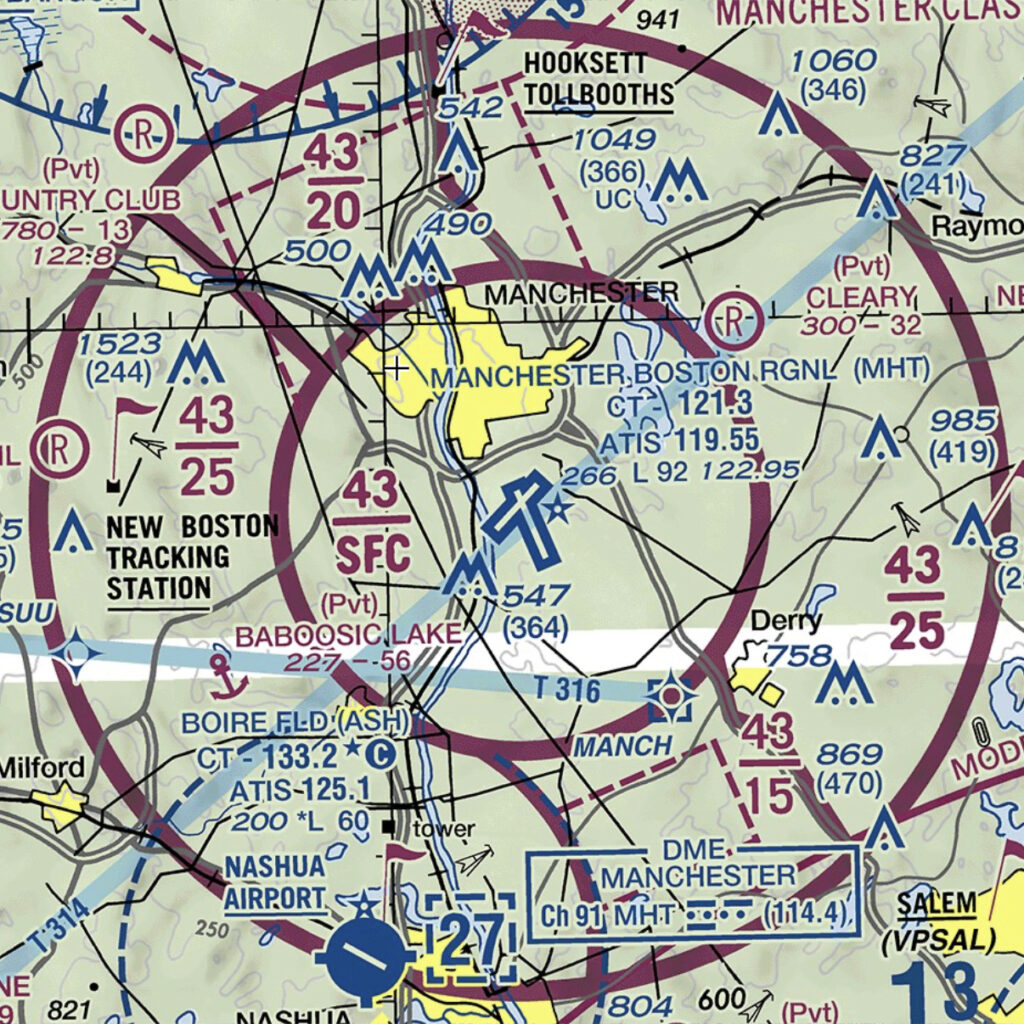
Although the configuration of each Class C area is individually tailored, the airspace usually consists of a surface area with a five NM radius, an outer circle with a ten NM radius that extends from 1,200 feet to 4,000 feet above the airport elevation.
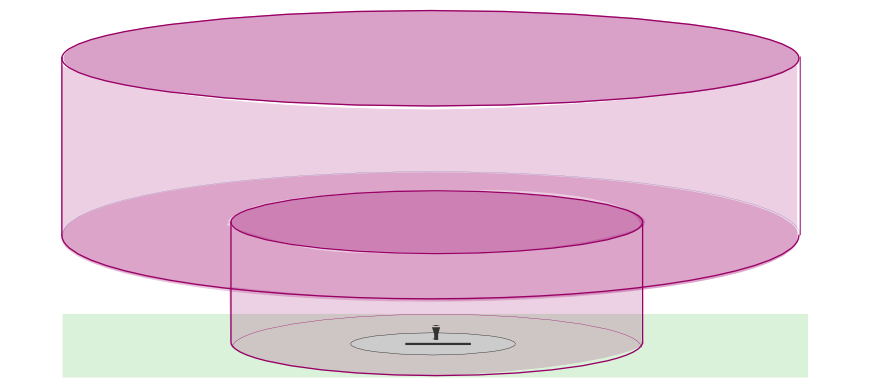
Each aircraft must establish two-way radio communications with the ATC facility providing air traffic services prior to entering the airspace and thereafter must maintain those communications while within the airspace.
Class D Airspace
Class D airspace is generally airspace from the surface to 2,500 feet above the airport elevation (charted in MSL) surrounding those airports that have an operational control tower. (i.e Hanscom Airport, Bedford MA.)
The configuration of each Class D airspace area is individually tailored and, when instrument procedures are published, the airspace is normally designed to contain the procedures. Arrival extensions for instrument approach procedures (IAPs) may be Class D or Class E airspace.
Unless otherwise authorized, each aircraft must establish two-way radio communications with the ATC facility providing air traffic services prior to entering the airspace and thereafter maintain those communications while in the airspace.
Operations
Pilots operating from a towered airport are required to maintain two-way radio communication with ATC and to acknowledge and comply with their instructions.
Pilots must advise ATC if they cannot comply with the instructions issued and request amended instructions. A pilot may deviate from an air traffic instruction in an emergency, but must advise ATC of the deviation as soon as possible.